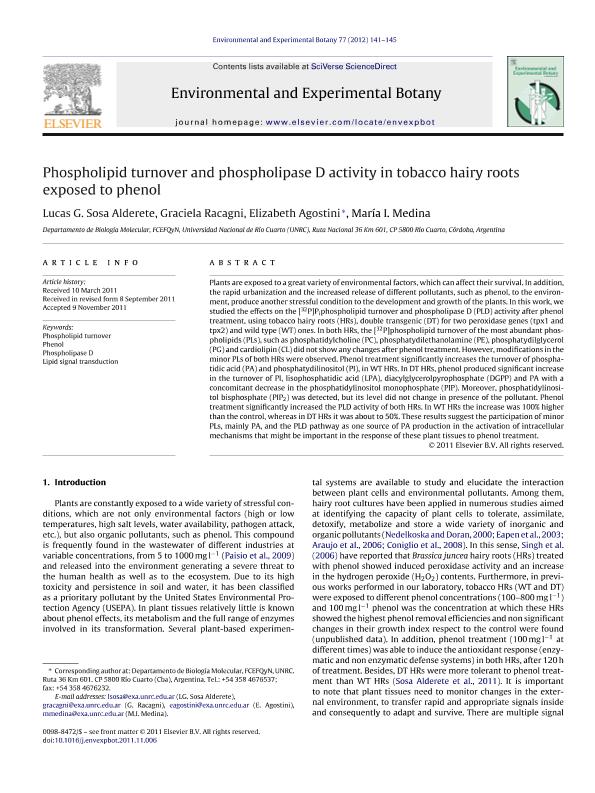Artículo
Phospholipid turnover and phospholipase D activity in tobacco hairy roots exposed to phenol
Fecha de publicación:
04/2012
Editorial:
Pergamon-Elsevier Science Ltd
Revista:
Environmental and Experimental Botany
ISSN:
0098-8472
e-ISSN:
1873-7307
Idioma:
Inglés
Tipo de recurso:
Artículo publicado
Clasificación temática:
Resumen
Plants are exposed to a great variety of environmental factors, which can affect their survival. In addition, the rapid urbanization and the increased release of different pollutants, such as phenol, to the environment, produce another stressful condition to the development and growth of the plants. In this work, we studied the effects on the [32P]Piphospholipid turnover and phospholipase D (PLD) activity after phenol treatment, using tobacco hairy roots (HRs), double transgenic (DT) for two peroxidase genes (tpx1 and tpx2) and wild type (WT) ones. In both HRs, the [32P]phospholipid turnover of the most abundant phospholipids (PLs), such as phosphatidylcholine (PC), phosphatydilethanolamine (PE), phosphatydilglycerol (PG) and cardiolipin (CL) did not show any changes after phenol treatment. However, modifications in the minor PLs of both HRs were observed. Phenol treatment significantly increases the turnover of phosphatidic acid (PA) and phosphatydilinositol (PI), in WT HRs. In DT HRs, phenol produced significant increase in the turnover of PI, lisophosphatidic acid (LPA), diacylglycerolpyrophosphate (DGPP) and PA with a concomitant decrease in the phosphatidylinositol monophosphate (PIP). Moreover, phosphatidylinositol bisphosphate (PIP2) was detected, but its level did not change in presence of the pollutant. Phenol treatment significantly increased the PLD activity of both HRs. In WT HRs the increase was 100% higher than the control, whereas in DT HRs it was about to 50%. These results suggest the participation of minor PLs, mainly PA, and the PLD pathway as one source of PA production in the activation of intracellular mechanisms that might be important in the response of these plant tissues to phenol treatment.32P]Piphospholipid turnover and phospholipase D (PLD) activity after phenol treatment, using tobacco hairy roots (HRs), double transgenic (DT) for two peroxidase genes (tpx1 and tpx2) and wild type (WT) ones. In both HRs, the [32P]phospholipid turnover of the most abundant phospholipids (PLs), such as phosphatidylcholine (PC), phosphatydilethanolamine (PE), phosphatydilglycerol (PG) and cardiolipin (CL) did not show any changes after phenol treatment. However, modifications in the minor PLs of both HRs were observed. Phenol treatment significantly increases the turnover of phosphatidic acid (PA) and phosphatydilinositol (PI), in WT HRs. In DT HRs, phenol produced significant increase in the turnover of PI, lisophosphatidic acid (LPA), diacylglycerolpyrophosphate (DGPP) and PA with a concomitant decrease in the phosphatidylinositol monophosphate (PIP). Moreover, phosphatidylinositol bisphosphate (PIP2) was detected, but its level did not change in presence of the pollutant. Phenol treatment significantly increased the PLD activity of both HRs. In WT HRs the increase was 100% higher than the control, whereas in DT HRs it was about to 50%. These results suggest the participation of minor PLs, mainly PA, and the PLD pathway as one source of PA production in the activation of intracellular mechanisms that might be important in the response of these plant tissues to phenol treatment.32P]phospholipid turnover of the most abundant phospholipids (PLs), such as phosphatidylcholine (PC), phosphatydilethanolamine (PE), phosphatydilglycerol (PG) and cardiolipin (CL) did not show any changes after phenol treatment. However, modifications in the minor PLs of both HRs were observed. Phenol treatment significantly increases the turnover of phosphatidic acid (PA) and phosphatydilinositol (PI), in WT HRs. In DT HRs, phenol produced significant increase in the turnover of PI, lisophosphatidic acid (LPA), diacylglycerolpyrophosphate (DGPP) and PA with a concomitant decrease in the phosphatidylinositol monophosphate (PIP). Moreover, phosphatidylinositol bisphosphate (PIP2) was detected, but its level did not change in presence of the pollutant. Phenol treatment significantly increased the PLD activity of both HRs. In WT HRs the increase was 100% higher than the control, whereas in DT HRs it was about to 50%. These results suggest the participation of minor PLs, mainly PA, and the PLD pathway as one source of PA production in the activation of intracellular mechanisms that might be important in the response of these plant tissues to phenol treatment.2) was detected, but its level did not change in presence of the pollutant. Phenol treatment significantly increased the PLD activity of both HRs. In WT HRs the increase was 100% higher than the control, whereas in DT HRs it was about to 50%. These results suggest the participation of minor PLs, mainly PA, and the PLD pathway as one source of PA production in the activation of intracellular mechanisms that might be important in the response of these plant tissues to phenol treatment.
Palabras clave:
PHENOL
,
PLD
,
PHOSPHOLIPIDS
,
SIGNAL TRANSDUCTION
Archivos asociados
Licencia
Identificadores
Colecciones
Articulos(CCT - CORDOBA)
Articulos de CTRO.CIENTIFICO TECNOL.CONICET - CORDOBA
Articulos de CTRO.CIENTIFICO TECNOL.CONICET - CORDOBA
Articulos(CIQUIBIC)
Articulos de CENTRO DE INVEST.EN QCA.BIOL.DE CORDOBA (P)
Articulos de CENTRO DE INVEST.EN QCA.BIOL.DE CORDOBA (P)
Citación
Sosa Alderete, Lucas Gastón; Racagni, Graciela Esther; Agostini, Elizabeth; Medina, María I.; Phospholipid turnover and phospholipase D activity in tobacco hairy roots exposed to phenol; Pergamon-Elsevier Science Ltd; Environmental and Experimental Botany; 77; 4-2012; 141-145
Compartir
Altmétricas




